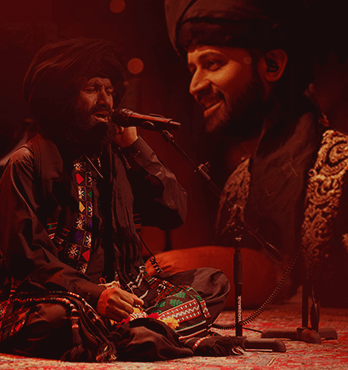Mubarik Mubarik

by Ayesha binte Rashid
Celebrating the rich relationship between music and wedding festivities in our part of the world, Mubarik Mubarik comes to us in the unique hues of the Baloch culture. The lyrics are simple and heartfelt, a mix of two genres of Baloch poetry and music: naazek and haalo. According to Chakar Baloch, Banur’s Band’s benjo player and the songwriter behind Mubarik Mubarik, naazek is a Balochi term that means to celebrate someone and praise them, to pray for all that is best for them.
In Mubarik Mubarik, we find poetry filled with naazek directed towards the bride and bridegroom, being sung by their relatives and friends. Expressing affection for the bride, the lyrics pray that her life be filled with happy days, as her sisters celebrate this reason to dress her up and decorate her. The singer congratulates the bridegroom and expresses their wish of always seeing the groom enjoy days that are filled with happiness shared with loved ones.
Mubarik Mubarik begins by calling people to join in the wedding celebrations: “Come, come,” the singer calls out, “haalo, haalo”. Haalo is a genre of geedi (folk) music and poetry in which the word haalo is repeated in verses to express the joy of an occasion, particularly a wedding. It is a sub-genre of naazek, Chakar explains, and an important part of Baloch culture, with thousands of songs and poems composed in the genre. “If one looks at the history of haalo, the genre has been around since the Baloch people have dwelled in this world,” says Chakar.
The joy of Mubarik Mubarik’s lyrics is expressed in the earthy voice of SM Baloch who, as the song approaches its crescendo, launches into a sargam, vocalising the sarbaney zahirok scale of Baloch music. Zahiroks are the raags of Baloch culture — this particular zahirok is named after the sarbans, or cameleers, who used to sing in its notes. Zahiroks are the basis of Baloch music, much like raags are the basis of Eastern Classical music, Chakar explains, and, according to local legends, the sarbaney zahirok took shape during the journeys of cameleers, as they sang to match their melodies and rhythms to their camels’ gaits and movements.
“The sarbaney zahirok is the most sung zahirok in Balochi,” Chakar says, “When you begin to learn music, you are taught the sarbaney zahirok first of all. When I began to learn the benjo, my ustad taught me this zahirok.”
Chakar goes on to paint a picture of the sarbans as they sung the zahirok on their long travels, “His camel is with him, he is in the mountains, and he is singing this zahirok in memory of a friend or a mehbooba (beloved). In the loneliness of the night, a moonlit night, he has a long journey to travel and he is dearly missing someone very close to him. To ward off this pain and grief, to express these feelings and emotions, he sings and he vocalizes sur (notes and pitches). The sarbaney zahirok is made by bringing together these emotions, the poetry he sings, and the sur he vocalizes.”
Zahirok have been preserved by being passed down through the generations through musical learning, Chakar explains, and there are more than 360 zahiroks in Baloch culture. While the sarbaney zahirok is one that was used to express melancholy and yearning by cameleers, just like raags, they can be used in any kind of musical arrangement and, as in Mubarik Mubarik, are also used in songs of celebration.
On its surface, Mubarik Mubarik seems like a simple, celebratory song, but for its creators, Chakar and composer Usman Withd, the song is the culmination of a long process of research and careful consideration, an effort to represent the traditions of Baloch music in contemporary colors that speak to the hearts of a wider audience.
In the process of writing this song, Chakar researched extensively on Baloch music, reading books and speaking to scholars and musicians, eventually drawn to the haalo genre. “Mubaarik didn’t come to me in a day or an hour. Gradually, I accumulated research, looked into poetry, into other haalos that have been made, in the thousands — I listened to them, to their lyrics, to the emotions that have been expressed in them, and then made a humble effort to form my own haalo,” he now says.
Usman provided the musical arrangement that brought Chakar’s lyrics together, driven by his motivation to design an experimental sound that represented Baloch music. “I wanted to make something different that people’s feet would not be able to stop moving to,” Usman says. When the song came to Usman it was, as he says, “bikhra hua (scattered),” and Usman amalgamated the zahirok and the lyrics, bringing them together into a musical arrangement and placing them over a rhythm.
The final piece in Mubarik Mubarik’s puzzle, and the third member of Banur’s Band, is SM Baloch, whose voice brings the song’s poetry to life. For Baloch, the song’s journey is not quick or easy either, it is peppered with challenges that are unique to him. “Uncle sings in the mountains,” explains Usman, “so the studio is a new environment for him. The scene in the mountains, the velocity, the reverb and the delay ... it’s all natural there. Uncle sings freely, he doesn’t sing on a tempo, he just calls out freely with his voice.”
When SM Baloch comes to the Studio for his first rehearsal, he has never even worn a pair of headphones, let alone sung on a click track. He is overwhelmed by the studio environment, by the myriad of sounds coming to him through the headphones he is wearing: “There were different voices coming [through the headphones] and I was dazed. The sound of the song was coming through, along with other, unfamiliar sounds. I was overwhelmed,” Baloch later says describing the experience. Used to singing freely in small gatherings, Baloch is also not used to singing to cues.
These hurdles seem insurmountable at first but, with the patient encouragement of the house band and his fellow performers, Baloch slowly adapts, and on the day of the recording, within three takes, Baloch has managed to give a performance that brings the song to life. The earthy vibrancy of his vibratos echoes out across the studio as he launches into the zahirok right on cue — a lesson in the adaptability of human nature and the magic of creative collaboration.
When the pieces come together, Mubarik Mubarik shines, at least to one particular artist, who finds the final outcome irresistible. “This is my favourite composition of the season, and when I heard it, I immediately said I have to do this,” says Atif Aslam, “I think this is an instinct that one has that says, ‘I want this, I want to do this and I think I can add value to it.’” Atif brings his own lyrics to the song, similar to those of Chakar’s, expressing the joys of a happy wedding. And so, Mubarik Mubarik becomes a collaboration, between Balochistan and Punjab, connecting the two languages and provinces through a song of celebration – pieces coming together through history and culture to form a colorful musical offering.
